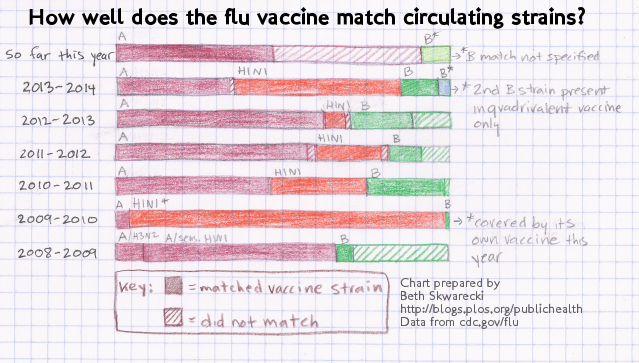The CDC announced recently that this year’s flu vaccine is missing a key strain, one that accounts for 48 per cent of what’s circulating. That strain, a “drifted” version of H3N2, was discovered in March 2014, but the vaccine strains for the Northern hemisphere, including the US, had been decided a month earlier. (The Southern hemisphere vaccine will include the drifted strain.)
Cue the overreactions: Natural News framed the advisory as an announcement that the vaccine “doesn’t work” (um, no) and a Fox News affiliate called the shot “useless” (likewise nope). The vaccine’s match is still better than 50 per cent; if you believed the hype and skipped the shot, you’d be protected against, oh right, 0 per cent.
“Doesn’t this happen every year?” was my friend’s reaction to the announcement that the vaccine wasn’t a good match. So I pulled up the CDC’s past reports to see how well the shot has been matching the circulating flu strains over the past few years. Take a look:

Well, hey. That’s actually pretty good.
Where these numbers come from:
There are two series of tests the CDC does. The first, which you’ll find under Virologic Surveillance in each report, gives the percentage of each type of flu relative to the others (A/H3N2, B, A/H1N1, etc) in samples that turned up positive at hospital labs. Not everybody gets tested, but we can assume the strains that show up here correspond roughly to what’s circulating.
To find out whether the vaccine is a match, animals’ antibodies are given a chance to attack samples of circulating flu strains. This is listed under Antigenic Testing. In a good year, the antibodies all do their job, or they do it maybe 99.5 per cent of the time and the last 0.5 per cent is beyond the resolution of my coloured pencils. The caveat here: only a small number of samples are tested in this way, so there is a risk of sampling bias, but once again it’s our best source of these numbers.
Most of the mismatches over the last few years came from B strain viruses. Flu vaccines often have just three strains: two A and one B. That’s called a trivalent vaccine. But if you get a chance to get the quadrivalent vaccine (which includes the nasal spray this year, and some but not all of the needle shots), you’re getting a second B strain. Last year, there were two types of B viruses that showed up in the test, and both were present in that year’s quadrivalent shot.
There’s another year on this chart with a big mismatch, and you may remember it: 2009, the grand entrance of a very special version of H1N1. That’s another case of a strain that popped up after the vaccine components had been decided, and so you might say that giant orange bar should be striped as a mismatch. But the threat from H1N1 was great enough that authorities commissioned a special second vaccine just to provide H1N1 coverage; I’ve written before about how I made sure to get that shot. I, and others who got both shots, were protected against nearly 100 per cent of the circulating flu.
An important caveat: we’re just talking here about which strains match; the question of the shot’s overall efficacy is an issue for another time. The shot doesn’t provide complete protection, although in most years, for most populations, it’s somewhere around 60-70 per cent effective for all the circulating strains combined. A meta-meta-analysis from 2012 summed it up like this:
“Most influenza vaccines have been shown to confer some protection against naturally acquired infection and no evidence for major harms has emerged. In adults and children, the efficacy/effectiveness of current seasonal vaccines was generally high for laboratory-confirmed cases (especially for [the nasal spray] in children aged 2 — 17 y), and modest for clinically-confirmed cases and for the elderly.”
Picture: Steven Depolo/Flickr
This post first appeared on PLoS Blogs and is republished here under Creative Commons licence.
